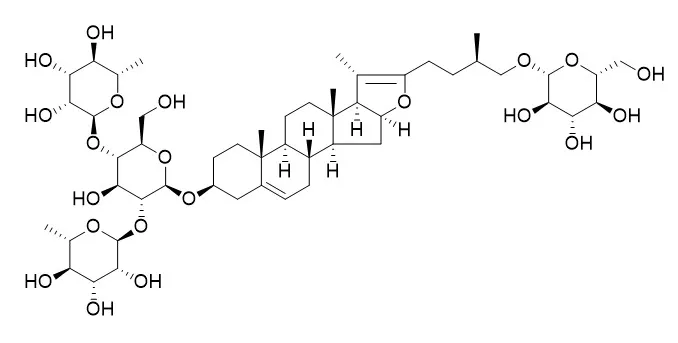| In vitro: |
| Planta Med. 2011 May;77(7):705-10. | | Anti-inflammatory and anti-melanogenic steroidal saponin glycosides from Fenugreek (Trigonella foenum-graecum L.) seeds.[Pubmed: 20979021 ] | Fenugreek seed ( Trigonella foenum-graecum L.) is used as an herbal medicine for treating metabolic and nutritive dysfunctions.
METHODS AND RESULTS:
To determine if this plant has other beneficial effects, we tested the inhibitory activities of a methanol (MeOH) extract of fenugreek seed on the production of inflammatory cytokines and melanin synthesis in cultured cell lines in vitro. The MeOH extract inhibited the production of phorbol-12-myristate-13-acetate-induced inflammatory cytokines such as tumor necrosis factor (TNF)-α in cultured THP-1 cells, and also restrained the intracellular synthesis of melanin in murine melanoma B16F1 cells. We isolated three active constituents from fenugreek seed extracts. These were identified as the steroidal saponins 26- O-β-D-glucopyranosyl-(25 R)-furost-5(6)-en-3 β,22 β,26-triol-3- O-α-L-rhamno-pyranosyl-(1'' → 2')-O-[β-D-glucopyranosyl-(1''' → 6')- O]-β-D-glucopyranoside 1, minutoside B 2, and Pseudoprotodioscin 3. Compounds 1 and 2 strongly suppressed the production of inflammatory cytokines, whereas 3 showed a weaker suppressing effect. Melanogenesis in B16F1 cells was significantly suppressed by 1 and 3, and weakly suppressed by 2. All three compounds showed moderate cytotoxicities.
CONCLUSIONS:
These results indicate that fenugreek extract and its active constituents could protect against skin damage. | | Planta Med. 2001 Dec;67(9):853-7. | | Two new steroidal saponins from the rhizomes of Dioscorea panthaica and their cytotoxic activity.[Pubmed: 11745024] | Two new steroidal saponins, dioscoresides C (1) and D (2), along with a new natural product, pregnadienolone 3-O-beta-gracillimatriose (3), and two known compounds, pregnadienolone 3-O-beta-chacotrioside (4) and Pseudoprotodioscin (5), were isolated from the rhizomes of Dioscorea panthaica Prain et Burkill.
METHODS AND RESULTS:
On the basis of extensive NMR studies and chemical evidence, dioscoresides C and D were determined to be 26-O-beta-D-glucopyranosyl-3 beta,26-dihydroxy-23(S)-methoxy-25(R)-furosta-5,20(22)-dien-3-O-alpha-L-rhamnopyranosyl-(1-->2)-[alpha-L-rhamnopyranosyl-(1-->4)]-beta-D-glucopyranoside and 26-O-beta-D-glucopyranosyl-3 beta,26-dihydroxy-20,22-seco-25(R)-furosta-5-en-20,22-dine-3-O-alpha-L-rhamnopyranosyl-(1-->2)-[alpha-L-rhamnopyranosyl-(1--> 4)]-beta-D-glucopyranoside.
CONCLUSIONS:
These compounds showed mild cytotoxicity against the cancer cell lines, A375, L929, and HeLa, in a dose-dependent manner. | | Fitoterapia . 2019 Nov;139:104393. | | Pseudoprotodioscin inhibits SREBPs and microRNA 33a/b levels and reduces the gene expression regarding the synthesis of cholesterol and triglycerides[Pubmed: 31669721] | | Abstract
The extract of Dioscorea zingiberensis C.H. Wright rhizomes is found to be effective in the therapy of cardiovascular disease. Steroidal saponins make substantial contribution. Previous study has proposed that methylprotodioscin (MP) may promote cholesterol efflux by increasing ABCA1 expression. But the other main saponins ingredients are not referred to. The aim of the present work was to reveal the effect and mechanism of protodioscin (PD), MP and Pseudoprotodioscin (PPD) on the synthesis-related gene expression of cholesterol and triglycerides. MTT assay apoptosis assay with annexin AV-APC and 7-AAD double staining were performed. MicroRNA assay and qRT-PCR were used to analyze the gene expression which regulates synthesis of cholesterol and triglycerides. Western blot was to demonstrate the levels of target proteins. Cholesterol efflux assay was executed to study the stimulative effect of saponins on cholesterol efflux. In Hep G2 cells, PPD increased ABCA1 protein and mRNA levels, and promoted the effluxion of ApoA-1-mediated cholesterol. The underlying mechanisms involved that PPD inhibited SREBP1c and SREBP2 transcription by decreasing microRNA 33a/b levels. This procedure reciprocally led to the increase of ABCA1 levels. In THP-1 macrophages, PPD showed the similar effect, which reduced HMGCR, FAS and ACC mRNA levels and promoted low density lipoprotein receptor by decreasing the PCSK9 levels. These studies demonstrated that PPD is a potential agent for cholesterol efflux, SREBPs and microRNA 33a/b inhibition, which related to the gene expression for the synthesis of cholesterol and triglycerides.
Keywords: Dioscorea zingiberensis C.H. Wright; Low density lipoprotein; Pseudoprotodioscin; SREBPs; microRNA 33a/b. |
|






 Cell. 2018 Jan 11;172(1-2):249-261.e12. doi: 10.1016/j.cell.2017.12.019.IF=36.216(2019)
Cell. 2018 Jan 11;172(1-2):249-261.e12. doi: 10.1016/j.cell.2017.12.019.IF=36.216(2019) Cell Metab. 2020 Mar 3;31(3):534-548.e5. doi: 10.1016/j.cmet.2020.01.002.IF=22.415(2019)
Cell Metab. 2020 Mar 3;31(3):534-548.e5. doi: 10.1016/j.cmet.2020.01.002.IF=22.415(2019) Mol Cell. 2017 Nov 16;68(4):673-685.e6. doi: 10.1016/j.molcel.2017.10.022.IF=14.548(2019)
Mol Cell. 2017 Nov 16;68(4):673-685.e6. doi: 10.1016/j.molcel.2017.10.022.IF=14.548(2019)